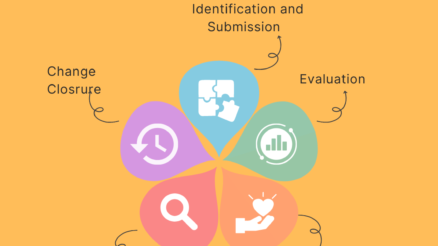Change is disruptive and difficult.
It often requires employees to adjust their work processes, responsibilities, and routines.
Employee buy-in is crucial for successful change management, and it requires a strategic approach that involves effective communication, addressing resistance to change, involving employees in the change process, creating a positive organizational culture, and providing training and support.
Getting employees buy-in is a make-or-break point of change management.
In this blog post, we will explore how to get employees to buy into change management, providing practical strategies and insights for businesses and organizations of all sizes.
Why it is important to get employees’ buy-in during change management?
Addressing resistance to change is important: Resistance to change can take many forms, including skepticism, fear of the unknown, lack of understanding or information, and a preference for the status quo. If left unaddressed, resistance can result in decreased productivity, employee disengagement, and ultimately, the failure of the change initiative.
Getting employees’ buy-in is a crucial component of addressing resistance to change because it helps to build trust, engagement, and commitment. When employees are involved in the change process and feel that their concerns and feedback are being heard and addressed, they are more likely to support the change initiative.
Employees are the ones who execute the change: Even if the leadership team has designed the perfect plan for change management, it is the employees who will ultimately execute it. Therefore, it is important to get their buy-in and support for the change initiative to ensure that the plan is implemented effectively and efficiently.
Employee buy-in fosters a culture of innovation: When employees are involved in the change process and feel that their opinions are valued, they are more likely to be engaged and invested in the success of the organization. This can foster a culture of innovation where employees are encouraged to think creatively and share their ideas, leading to better problem-solving and increased competitiveness in the market. Therefore, employee buy-in not only supports the success of a specific change initiative but can also have long-term benefits for the organization.
Employee buy-in can increase job satisfaction and retention: When employees feel valued and involved in the change process, they are more likely to feel a sense of satisfaction and fulfillment in their jobs. This can lead to increased engagement, productivity, and commitment to the organization. In addition, employees who feel invested in the success of the organization are more likely to stay with the company, reducing turnover and associated costs.
10 Ways to Get Employees’ Buy-in during Change Management
Here are top 10 ways to get employees’ buy-in during change management:
1. Communicate the “why”
Communicating the “why” is a crucial component of getting employees’ buy-in during change management. Employees want to understand the reasons behind the change initiative, including how it will benefit the organization, employees, and customers. Leaders should clearly communicate the purpose and goals of the change initiative, outlining what the organization is trying to achieve and why it is important.
By providing this context, employees can better understand how their work contributes to the overall success of the organization and how the change initiative will impact their day-to-day work. This can help to build a sense of purpose and investment in the change, increasing the likelihood of employee buy-in and support.
2. Involve employees in planning process
Involving employees in the planning process is a key strategy for getting their buy-in during change management. When employees are invited to provide feedback, suggestions, and ideas, they feel more invested in the change initiative and are more likely to support it. By involving employees in the planning process, leaders can tap into their expertise, knowledge, and insights, leading to more effective and efficient solutions.
This can also help to identify potential roadblocks or issues that may not have been apparent otherwise. In addition, involving employees in the planning process can help to build trust and transparency, demonstrating that their input and ideas are valued and important.
3. Address their concerns and objections
Addressing concerns and objections is an essential step in getting employee buy-in during change management. Employees may have legitimate concerns or objections to the change, and addressing them is critical to building trust and credibility. Leaders should take the time to listen to employees’ concerns and objections and provide thoughtful and transparent responses.
This can help to ease anxiety and uncertainty, building a sense of trust and confidence in the change initiative. By addressing concerns and objections, leaders can also demonstrate a willingness to consider alternative perspectives and ideas, which can further increase employee buy-in and support.
Ultimately, addressing concerns and objections can help to build a more collaborative and inclusive culture, leading to a more successful change initiative
4. Recognize and reward success
Recognizing and rewarding success is an important strategy for getting employee buy-in during change management. Celebrating milestones and successes along the way can help to build momentum and reinforce the benefits of the change.
By recognizing and rewarding success, leaders can demonstrate their appreciation for employees’ efforts and contributions, building a sense of pride and motivation. This can help to build a positive and supportive culture, where employees feel valued and recognized for their hard work.
Additionally, recognizing and rewarding success can help to build excitement and engagement, encouraging employees to continue to invest in the change initiative.
5. Build a coalition of support
Building a coalition of support is a critical strategy for getting employee buy-in during change management. This involves identifying and engaging key stakeholders who can act as champions and advocates for the change initiative.
By building a coalition of support, leaders can tap into the influence and expertise of these stakeholders, leveraging their networks and credibility to build support for the change initiative.
This can help to build momentum and credibility for the change initiative, increasing the likelihood of successful implementation.
6. Be transparent
Being transparent is a key strategy for getting employee buy-in during change management. Leaders should communicate openly and honestly with employees throughout the change process, sharing information about the change initiative, its progress, and any challenges or roadblocks.
By being transparent, leaders can build trust and credibility with employees, demonstrating a commitment to openness and collaboration.
This can help to build a sense of ownership and investment in the change initiative, as employees feel more connected to the process and outcomes.
7. Communicate continuously and update
Continuously communicating and updating employees is a crucial strategy for getting employee buy-in during change management. Leaders should communicate frequently and regularly throughout the change process, providing updates on progress, challenges, and milestones. By doing so, leaders can keep employees informed and engaged, demonstrating a commitment to transparency and collaboration.
Continuous communication can help to address any concerns or objections that arise, allowing leaders to respond in real-time and build trust and confidence in the change initiative. By keeping employees engaged and informed, leaders can also build a sense of ownership and investment in the change initiative, as employees feel more connected to the process and outcomes.
Overall, continuously communicating and updating can help to build a more positive and supportive culture, leading to a more successful change initiative
8. Break change into small parts
Breaking change into small parts is a valuable strategy for getting employee buy-in during change management. Change initiatives can often be overwhelming, and breaking them down into smaller, more manageable parts can help to reduce resistance and anxiety.
By breaking change into smaller parts, leaders can help employees to focus on specific tasks or goals, building a sense of progress and accomplishment. This can help to build momentum and motivation, making it easier for employees to adapt to the change.
Additionally, breaking change into smaller parts can help to identify any challenges or roadblocks early on, allowing leaders to respond proactively and make adjustments as needed.
Overall, breaking change into small parts can help to build a more collaborative and engaged workforce, leading to a more successful change initiative.
9. Engage organizational influencers
Engaging organizational influencers is an effective strategy for getting employee buy-in during change management. These influencers are individuals who hold significant positions of authority or influence within the organization, such as senior executives, department heads, or influential employees.
By engaging these influencers, leaders can leverage their networks and credibility to build support for the change initiative. This can help to build momentum and credibility for the change, increasing the likelihood of successful implementation.
Additionally, engaging organizational influencers can help to build a culture of support and collaboration, demonstrating a willingness to work together towards a common goal.
By working with these influencers, leaders can also gain valuable insights and perspectives on the change initiative, helping to identify potential challenges or opportunities.
Overall, engaging organizational influencers can help to build a more collaborative and committed workforce, leading to a more successful change initiative
10. Launch a targeted campaign
Launching a targeted campaign to influence behavior is another effective strategy for gaining employee buy-in during change management. This involves using marketing and communication techniques to promote the benefits of the change initiative and encourage employees to adopt new behaviors or practices. A targeted campaign can include a range of activities, such as creating promotional materials, organizing training sessions, and launching internal communications through email, newsletters, or social media.
By creating a consistent message and promoting the benefits of the change, leaders can help to build momentum and support for the initiative.
By targeting specific behaviors or practices, leaders can help to ensure that employees understand the changes that are required and have the tools and resources they need to implement them effectively.
Launching a targeted campaign can help to create a more engaged and informed workforce, leading to a more successful change initiative.
Final Words
Successfully managing change within an organization is critical for achieving long-term success and growth. However, achieving buy-in from employees can be a challenging task. By following the ten strategies outlined in this article, leaders can increase the likelihood of successfully gaining employee buy-in during change management.



